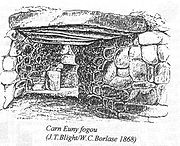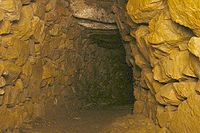
Fogou
Encyclopedia

Iron Age
The Iron Age is the archaeological period generally occurring after the Bronze Age, marked by the prevalent use of iron. The early period of the age is characterized by the widespread use of iron or steel. The adoption of such material coincided with other changes in society, including differing...
or Romano-British
Romano-British
Romano-British culture describes the culture that arose in Britain under the Roman Empire following the Roman conquest of AD 43 and the creation of the province of Britannia. It arose as a fusion of the imported Roman culture with that of the indigenous Britons, a people of Celtic language and...
defended settlement sites in Cornwall. Fogous have similarities with souterrains or earth-houses of northern Europe and particularly Scotland
Scotland
Scotland is a country that is part of the United Kingdom. Occupying the northern third of the island of Great Britain, it shares a border with England to the south and is bounded by the North Sea to the east, the Atlantic Ocean to the north and west, and the North Channel and Irish Sea to the...
including the Orkney Islands
Orkney Islands
Orkney also known as the Orkney Islands , is an archipelago in northern Scotland, situated north of the coast of Caithness...
. Fewer than 15 confirmed fogous have been found.
Construction
Fogous consist of a buried, usually corbelCorbel
In architecture a corbel is a piece of stone jutting out of a wall to carry any superincumbent weight. A piece of timber projecting in the same way was called a "tassel" or a "bragger". The technique of corbelling, where rows of corbels deeply keyed inside a wall support a projecting wall or...
led stone wall, tapering at the top and capped by stone slabs. They were mainly constructed by excavating a sloping trench about 5 ft (1.5 m) wide and 6 ft (1.8 m) deep, lining it with drystone walling as stated, which was battered inwards and roofed with flat slabs; soil from excavation was heaped on top as at Pendeen Vau or incorporated in the rampart of the enclosure as at Halliggye Fogou
Halliggye Fogou
Halliggye Fogou is one of many fogous in Cornwall, England, United Kingdom.The site is under the guardianship of English Heritage, and managed by The Trelowarren Estate...
, Trelowarren.
Function
The purpose of a fogou is no longer known. It has been conjectured that they were used for religious purposes, as refuges, or for food storage. Many are oriented south-west-north-east, facing the prevailing wind. Their central location in settlements and the work that evidently went into constructing them is indicative of their importance to the community, which gives credence to a religious or ceremonial function. In 2004, Kenneth Lyden, during his M.A dissertation, proposed a new use for Fogous, that of refuge during raiding trips. Before then this had not been considered.He continues his arguments that food storage is impractical due to the damp conditions, and he also examined the role of ritual usage. He discounts the role of Druids, as in Celtic tradition they focus more on the living world and were not involved with Standing stones, circles or Henges. He concludes that, although ritual use cannot be ruled out, it does become more unlikely.The word derives from the Celtic
Celtic languages
The Celtic languages are descended from Proto-Celtic, or "Common Celtic"; a branch of the greater Indo-European language family...
*ifócw, meaning "cave
Cave
A cave or cavern is a natural underground space large enough for a human to enter. The term applies to natural cavities some part of which is in total darkness. The word cave also includes smaller spaces like rock shelters, sea caves, and grottos.Speleology is the science of exploration and study...
". In the past, locals in Cornwall have called them "fuggy-holes" but this term is seldom used today. Being open at both ends, a fogou could provide ideal conditions for food storage, especially the drying of meat. Ashpits found at Trewardreva and in the circular side-chamber at Carn Euny
Carn Euny
Carn Euny is an archaeological site near Sancreed, on the Penwith peninsula in Cornwall, United Kingdom with considerable evidence of both Iron Age and post-Iron Age settlement. Excavations on this site have shown that there was activity at Carn Euny as early as the Neolithic period...
were probably for preserving gulls eggs, as was done on Saint Kilda
St Kilda, Scotland
St Kilda is an isolated archipelago west-northwest of North Uist in the North Atlantic Ocean. It contains the westernmost islands of the Outer Hebrides of Scotland. The largest island is Hirta, whose sea cliffs are the highest in the United Kingdom and three other islands , were also used for...
. A layer of black greasy mould with charcoal, animals and bird bones at Treveneague is also very suggestive of food storage. Diodorus Siculus
Diodorus Siculus
Diodorus Siculus was a Greek historian who flourished between 60 and 30 BC. According to Diodorus' own work, he was born at Agyrium in Sicily . With one exception, antiquity affords no further information about Diodorus' life and doings beyond what is to be found in his own work, Bibliotheca...
stated that Iron Age people in Britain stored their grain in "underground repositories", adding contemporary evidence to the speculation that they were mainly used for food storage. Excavated examples at Halliggye
Halliggye Fogou
Halliggye Fogou is one of many fogous in Cornwall, England, United Kingdom.The site is under the guardianship of English Heritage, and managed by The Trelowarren Estate...
, Carn Euny and Boden
Boden
Boden is the surname of these notable persons:* Fernand Boden, politician from Luxembourg* Jens Boden, German speed skater* Maggie Boden, British artificial intelligence researcher* Paul Boden, American activist for the homeless...
suggest fogous may have been deliberately filled after use or upon abandonment of the associated settlements.
History & archaeology

Tacitus
Publius Cornelius Tacitus was a senator and a historian of the Roman Empire. The surviving portions of his two major works—the Annals and the Histories—examine the reigns of the Roman Emperors Tiberius, Claudius, Nero and those who reigned in the Year of the Four Emperors...
describes the Germans
Germans
The Germans are a Germanic ethnic group native to Central Europe. The English term Germans has referred to the German-speaking population of the Holy Roman Empire since the Late Middle Ages....
hollowing out underground caves, covering them with manure and using them as storehouses and refuges from winter frosts. He also claimed that they hid in their boltholes to escape detection by raiders, which is one function of the souterrain
Souterrain
Souterrain is a name given by archaeologists to a type of underground structure associated mainly with the Atlantic Iron Age. These structures appear to have been brought northwards from Gaul during the late Iron Age. Regional names include earth houses, fogous and Pictish houses...
s of Gaul and early medieval Ireland. Fogous may have had a similar function to the underground kivas of the Native American
Native Americans in the United States
Native Americans in the United States are the indigenous peoples in North America within the boundaries of the present-day continental United States, parts of Alaska, and the island state of Hawaii. They are composed of numerous, distinct tribes, states, and ethnic groups, many of which survive as...
s.
Other underground structures such as "earth houses" or souterrains have some similarities with fogous. An example of an excavated souterrain is the site at Rosal, strath Naver, Sutherland. In this example no finds were made inside the structure and the roof may have been only partially covered with stones, a timber roof being present on part of it. It was suggested that souterrains could have been used as byres or barns. Fogous are often associated with dwellings such as Iron Age
Iron Age
The Iron Age is the archaeological period generally occurring after the Bronze Age, marked by the prevalent use of iron. The early period of the age is characterized by the widespread use of iron or steel. The adoption of such material coincided with other changes in society, including differing...
villages.
Petrosphere
Petrosphere
In archaeology, a petrosphere is the name for any spherical man-made object of any size that is composed of stone. These mainly prehistoric artefacts may have been created and/or selected, but altered in some way to perform their specific function, including carving and painting.Several classes of...
s or "stone balls" have been found in souterrain
Souterrain
Souterrain is a name given by archaeologists to a type of underground structure associated mainly with the Atlantic Iron Age. These structures appear to have been brought northwards from Gaul during the late Iron Age. Regional names include earth houses, fogous and Pictish houses...
s and, as possible symbols of power within prehistoric society, this discovery suggest a use other than basic storage of food and resources.
Fogou sites

Halliggye Fogou
Halliggye Fogou is one of many fogous in Cornwall, England, United Kingdom.The site is under the guardianship of English Heritage, and managed by The Trelowarren Estate...
on the Trelowarren estate is generally accepted to be the largest and best surviving fogou. It is recommended by the Reader's Digest guide. It is signed from the B3293 near Garras off the A3083. The site is open daily from April through to October. OSGB grid reference SW 17129,02395, Lat/Long 50.07162 N, 5.19749W
Other unspoiled fogous survive at Carn Euny
Carn Euny
Carn Euny is an archaeological site near Sancreed, on the Penwith peninsula in Cornwall, United Kingdom with considerable evidence of both Iron Age and post-Iron Age settlement. Excavations on this site have shown that there was activity at Carn Euny as early as the Neolithic period...
; Boleigh near Lamorna; Pendeen and at Trewardreva near Constantine
Constantine, Kerrier
Constantine is a village and civil parish in Cornwall, United Kingdom. It is situated approximately five miles west-southwest of Falmouth....
, which is known locally as Pixie's Hall
Pixie
Pixies are mythical creatures of folklore, considered to be particularly concentrated in the areas around Devon and Cornwall, suggesting some Celtic origin for the belief and name.They are usually depicted with pointed ears, and often wearing a green outfit and pointed...
or Piskey Hall.
Partially destroyed fogous exist at Chysauster
Chysauster Ancient Village
Chysauster Ancient Village is a late Iron Age and Romano-British village of courtyard houses in Cornwall, England, United Kingdom, which is currently in the care of English Heritage...
, which is in the care of English Heritage and which has been blocked up for safety; at Boden Vean near Manaccan and at Lower Boscaswell close to Pendeen.
Evidence of possible former fogous can be found at Porthmeor; at Higher Bodinar; at Castallack and at Treveneague. Another was found during rescue excavations at Penhale Round on the A30, the most easterly example, but this has since been destroyed.
One of the northern-most fogou sites is Castle Bloody
Castle Bloody
Castle Bloody is a prehistoric feature on the island of Shapinsay, Orkney, Scotland. Hogan observes that while the feature is marked as a chambered mound on the UK Ordnance Survey map, the structure is more properly and specifically classified as a souterrain or earth house. Slightly to the north...
on the island of Shapinsay
Shapinsay
Shapinsay is one of the Orkney Islands off the north coast of mainland Scotland. There is one village on the island, Balfour, from which roll-on/roll-off car ferries sail to Kirkwall on the Orkney Mainland...
in the Orkney Islands
Orkney Islands
Orkney also known as the Orkney Islands , is an archipelago in northern Scotland, situated north of the coast of Caithness...
of Scotland
Scotland
Scotland is a country that is part of the United Kingdom. Occupying the northern third of the island of Great Britain, it shares a border with England to the south and is bounded by the North Sea to the east, the Atlantic Ocean to the north and west, and the North Channel and Irish Sea to the...
.

